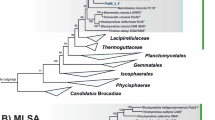Abstract
The ultrastructure of a budding and appendaged bacterium resemblingPlanctomyces guttaeformis Hortobágyi (sensu Hajdu) was examined by transmission electron microscopy in negative-contrast and thin-section preparations from samples of pond and lake water in which natural blooms of this organism had occurred. Its prokaryotic nature was established, and observations were reported regarding its characteristic bulbiform or bulbose cell shape (cylindrical with one globose or swollen end), budding process, crateriform surface structures, rosettes (cell clusters) radiating from the narrow (nonglobose) ends of the adhering cells, cell envelope profile, and distinctive appendages (a single, relatively broad and long, gradually tapered, rigid, multifibrillar, polar or slightly subpolar, noncellular spike—without the adherence function of a stalk—located at the swollen pole of the bulbiform cell; numerous pili/fimbriae all over the globose portion). These traits establish the organism as a putative member of theBlastocaulis-Planctomyces group of budding and appendaged bacteria, but sufficiently distinctive (bulbiform cell shape; spike; adherent material at narrow end of cell rather than at the end of a noncellular appendage) to warrant its delineation as morphotype V of this group.
Similar content being viewed by others
Literature Cited
Hajdu, L. 1973. Electron microscope examinations made on microorganisms of fishponds. Mikroskopie. Zentralblatt für Mikroskopische Forschung und Methodik29:49. [Abstract.]
Hajdu, L. 1974. Observations on the bacterium speciesPlanctomyces guttaeformis Hortob. (Caulobacteriales). Archiv für Hydrobiologie74:172–185.
Heynig, H. 1961. Zur Kenntnis des Planktons mitteldeutscher Gewässer. Archiv für Protistenkunde105:407–416.
Hirsch, P., Skuja, H. 1974. GenusPlanctomyces, pp. 162–163. In: Buchanan, R. E., Gibbons, N. E. (eds.) Bergey's manual of determinative bacteriology, 8th ed. Baltimore: Williams & Wilkins.
Hirsch, P., Müller, M., Schlesner, H. 1977. New aquatic budding and prosthecate bacteria and their taxonomic position, pp. 107–133. In: Skinner, F. A., Shewan, J. M. (eds.), Aquatic microbiology. London: Academic Press.
Hortobágyi, T. 1965. [Neue Planctomyces-Arten.] Botanikai Közlemények.52:111–115. [In Hungarian, with German résumé.]
Hortobágyi, T. 1968. Planctomyces from Vietnam. Acta Phytopathologica Academiae Scientiarum Hungaricae3:271–273.
Hubert, E. G., Potter, C. S., Hensley, T. J., Cohen, M., Kalmanson, G. M., Guze, L. B. 1971. L-forms ofPseudomonas aeruginosa. Infection and Immunity4:60–72.
Schmidt, J. M. 1978. Isolation and ultrastructure of freshwater strains ofPlanctomyces. Current Microbiology1:65–70.
Schmidt, J. M., Starr, M. P. 1978. Morphological diversity of freshwater bacteria belonging to theBlastocaulis-Planctomyces group as observed in natural populations and enrichments. Current Microbiology1:325–330.
Wawrik, F. 1952.Planctomyces-Studien. Sydowia6:443–452.
Author information
Authors and Affiliations
Rights and permissions
About this article
Cite this article
Schmidt, J.M., Starr, M.P. Morphotype V of theBlastocaulis-Planctomyces group of budding and appendaged bacteria:Planctomyces guttaeformis Hortobágyi (sensu Hajdu). Current Microbiology 2, 195–200 (1979). https://doi.org/10.1007/BF02601711
Issue Date:
DOI: https://doi.org/10.1007/BF02601711




